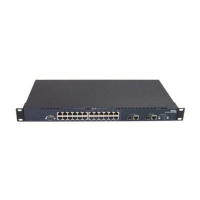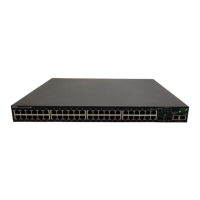250 BigIron RX Series Configuration Guide
53-1002253-01
Deploying a LAG
8
Act Indicates the link aggregation mode, which can be one of the following:
• No – The mode is passive on the port.
If link aggregation is enabled (and the mode is passive), the port
can send and receive LACPDU messages to participate in
negotiation of an aggregate link initiated by another port, but
cannot search for a link aggregation port or initiate negotiation of
an aggregate link.
• Yes – The mode is active. The port can send and receive LACPDU
messages.
Tio Indicates the timeout value of the port. The timeout value can be one of
the following:
• L – Long. The trunk group has already been formed and the port is
therefore using a longer message timeout for the LACPDU
messages exchanged with the remote port. Typically, these
messages are used as confirmation of the health of the aggregate
link.
• S – Short. The port has just started the LACPDU message
exchange process with the port at the other end of the link. The S
timeout value also can mean that the link aggregation information
received from the remote port has expired and the ports are
starting a new information exchange.
Agg Indicates the link aggregation state of the port. The state can be one of
the following:
• Agg – Link aggregation is enabled on the port.
• No – Link aggregation is disabled on the port.
Syn Indicates the synchronization state of the port. The state can be one of
the following:
• No – The port is out of sync with the remote port. The port does not
understand the status of the LACPDU process and is not prepared
to enter a trunk link.
• Syn – The port is in sync with the remote port. The port
understands the status of the LACPDU message exchange process,
and therefore knows the trunk group to which it belongs, the link
aggregation state of the remote port, and so on.
Col Indicates the collection state of the port, which determines whether the
port is ready to send traffic over the trunk link.
• Col – The port is ready to send traffic over the trunk link.
• No – The port is not ready to send traffic over the trunk link.
Dis Indicates the distribution state of the port, which determines whether
the port is ready to receive traffic over the trunk link:
• Dis – The port is ready to receive traffic over the trunk link.
• No – The port is not ready to receive traffic over the trunk link.
TABLE 58 Show LAG information (Continued)
This field... Displays...

